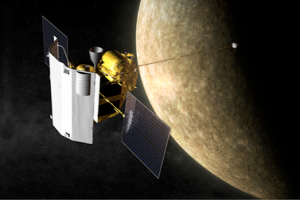Opportunity: Exploring a much smaller crater of its own, Victoria Crater-Spirit's twin, Opportunity, continues its investigation of the rock layers of Mars' geological history. As of June 10, Opportunity has clocked in at 7.26 miles of total "roving" on Mars, since its landing back in 2004.
Phoenix: The brand-spankin'-new Mars Phoenix lander has been digging into one of Mars' greatest scientific mysteries: water. Detailed chemical analysis of samples taken at Phoenix's site near the northern polar ice cap is underway, but the big question-- is Phoenix standing on frozen Martian water-- has been answered: yes.
Mars Reconnaissance Orbiter: The newest orbiter in the Martian fleet continues to send back its extreme-high-resolution imagery and its revealing chemical measurements, as well as to serve as a high-speed data and communication relay for other Mars-exploring robots.
Mars 2001 Odyssey: Credited with detecting the massive amounts of frozen water in Mars' northern hemisphere-the same ice that the Phoenix lander is now scraping at, Mars 2001 Odyssey continues its surveillance of Mars' chemistry and atmosphere.
Mars Express: The European orbiter that launched the ill-fated Beagle II lander has continued on a respectable career of exploration in its own right. Mars Express also helped support the landing of the Phoenix.
Cassini: Saturn's first robot-in-residence, Cassini, has concluded its initial 4-year mission and is now continuing on an extended mission. Cassini has given us unprecedented close-up images and measurements of many of Saturn's stunning moons, its complicated ring system, and the swirling, aurora-touched cloud formations of Saturn itself.
MESSENGER: The first spacecraft to visit the little-understood Mercury since 1975 made its first flyby of that planet last January, and will settle into a permanent orbit in March 2011. Even the few pics it snapped as it hurled by gave us far more detailed images of Mercury than ever before.
New Horizons: Launched a couple years ago on its outward bound, meteoric flight to Pluto, New Horizons has already performed some exploration duty, capturing images and data of Jupiter, Jupiter's volcanic moon Io, and Jupiter's long magnetic "tail." Now in "cruise mode," this little robot will fly past Pluto (dwarf planet; king of the Plutoids) in July 2015.
Voyagers 1 and 2: Do you remember the remarkable voyages of discovery made by the Voyager spacecraft, both launched in 1977? Since completing their primary missions of flying by the Gas Giant planets (Voyager 1 at Jupiter and Saturn, Voyager 2 at all four), these two veterans have continued to operate and send information back to Earth, and are now about 3 times more distant from the Sun than Pluto.
That's the wrap. If I missed anyone, my apologies!
37.7631 -122.409
 NASA's MESSENGER spacecraft at Mercury-artist concept.
NASA's MESSENGER spacecraft at Mercury-artist concept.